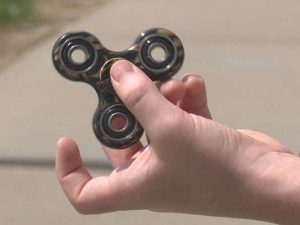The joy of fidgeting: how fidget spinners took over the world
Do Fidget Spinners help Children Learn?
You see them everywhere, a colourful blur right across the country, wherever there are children. Where once it was marbles or loom bands or bottle flips, the fidget spinner has become the craze of 2017. But how did this toy, designed to help children who have issues with concentrating, become the go-to gadget of our times? And have we lost sight of what they’re really meant to be used for?
The classroom can be a daunting experience for some of us. A number of conditions, including Autism Spectrum Disorder (ASD), attachment behaviour disorder (ABD), and attention deficit hyperactivity disorder (ADHD), mean that it’s harder to be “ready to learn” than your peers.
While most children (and adults) find it possible, if not always desirable, to sit in silence and focus on one other person talking, for others it’s more of a challenge. The sensory deprivation can leave some of us feeling agitated, on edge, with nervous energy that’s hard to keep in check. In a classroom environment this can manifest itself in all kinds of (for the educator) unwanted behaviour which are (for the learner) an aid to concentration. From calling out and interrupting to flipping rulers on desks or folding paper, educators find that learners’ self-therapy can be distracting and take away from the flow of a lesson. So is there another way of coping?
The theory of fidget toys is simple: if you have difficulty concentrating, it gives you something to occupy your senses. The pleasant whirr of the spinner as its outer spokes whirl around the central hub creates a light vibration. Watching the spokes slowly come to a halt – they run on ceramic or steel bearings – is a strangely satisfying experience, as it takes just that little bit longer than your brain expects.
 In a classroom environment it can be easy for an educator to mistake this behaviour for disruption, whereas it is in fact an expression of unfocused energy or repetitive behaviour that the child finds useful in order to concentrate and be ready to learn, particular when around others. While some children with special educational needs find it more stressful to be in a noisy classroom, others find the silent “teacher talk, you listen” sections of a lesson to be the most challenging.
In a classroom environment it can be easy for an educator to mistake this behaviour for disruption, whereas it is in fact an expression of unfocused energy or repetitive behaviour that the child finds useful in order to concentrate and be ready to learn, particular when around others. While some children with special educational needs find it more stressful to be in a noisy classroom, others find the silent “teacher talk, you listen” sections of a lesson to be the most challenging.
Fidget toys provide an outlet for the energy these learners – adults as well as children – need to dissipate, in such a way as to be a minimal distraction for those around them, and teachers too. It allows a child to express their needs and be as stress-free as possible, without hindering the learning of others.
Educators, learning mentors, learning support assistants and play therapists will be familiar with “busy boxes” and sensory equipment for children who have special educational needs. Traditionally, sensory toys have been cobbled together from other toys and ordinary household items, for example – but the fidget spinner, and its cousin the fidget cube, were specifically designed to help learning.
Whether that means they are more effective than what professionals have been using for years is up for debate. And whether it’s more helpful to have fidget toys to be used in the classroom, rather than during specially timetabled sensory breaks, is another issue. But there’s no debating how popular these toys have become among all kinds of children – and their purpose has changed, from their original mission to all-round craze and, as we see them now, a phenomenon.
Now you can find not just three-pronged spinners but two and four-pronged spinners, glittering colours, even with LEDs to sparkle underneath a desk or in a dim room. And so have come the tricks that have elevated these toys from their purpose to something entirely different: as the hula hoop of our times. With that popularity has come cheap imitation, of course, leading to German authorities seizing millions of potentially lethal spinners and planning to crush them.
The prevalence of spinners has led to some schools banning them outright, and others making them disappear from the classroom, allowed during breaktimes. This policy, while understandable, might be a little hasty, since the benefits of these toys are not yet fully understood. As an educator, I have seen them being used effectively already with children who have additional learning needs, to give them something to keep their hands busy and their minds occupied during teacher input. So while it might be irritating to see that blur out of the corner of our eyes, it might be best to consider they really might have a positive value to learning after all.

